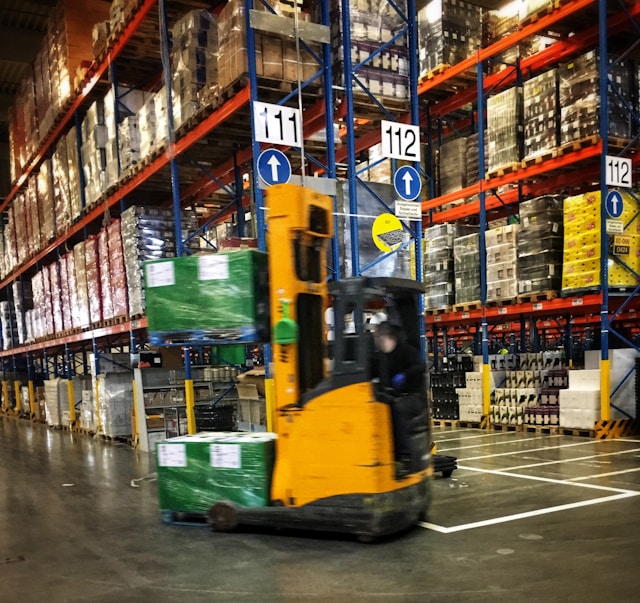In today’s fast-changing business world, companies often struggle to balance how much they produce with how much customers want. This challenge, called managing production capacity, is a big deal for businesses in all kinds of industries.
Whether it’s because of seasonal changes, trends in the market, or unexpected problems, having too much or too little stuff ready to sell can cause problems.
In this blog post, we’ll talk about some smart ways businesses can handle these ups and downs in demand and make sure they’re making the right amount of products at the right time.
Before we go further into this topic, don’t forget to follow my LinkedIn account. You’ll get more helpful insights on supply chain management there.
Table of Contents
Forecasting: Anticipating the Future
Forecasting demand is super important for businesses to plan how much they need to produce. It’s like a roadmap that helps them figure out how many resources they need and when to make stuff.
They do this by looking at past sales, keeping an eye on what’s happening in the market, and gathering information from different places.
By doing this, they can understand what makes people buy things and predict how much they’ll want in the future.
Once businesses have a good idea of what customers will want, they can plan ahead and use their resources wisely. They can adjust their production schedules and use their manpower, materials, and equipment efficiently to meet demand without wasting anything.
Plus, if they see any potential problems in the production process, like bottlenecks or shortages, they can fix them before they become a big issue.
Overall, being able to predict demand helps businesses run smoother, save money, and stay competitive.

By making sure they’re making just the right amount of products at the right time, they can use their resources better, streamline their processes, and get their products out to customers faster.
It also helps them make smart decisions about growing their business or managing their inventory based on what they know about future demand.
In a world where things can change fast, being able to see what’s coming helps businesses stay successful in the long run.
Flexibility in Production: Agility is Key
In today’s fast-changing business world, companies need to be super flexible in how they make stuff. This flexibility isn’t just helpful—it’s a must if they want to stay ahead.
Agile manufacturing practices help businesses quickly adapt to changes in what customers want, whether there’s suddenly a lot more demand or things slow down unexpectedly.
By being nimble in how they operate, companies can handle uncertainties and grab opportunities when they pop up.
A big part of agile manufacturing is being able to change how much stuff they make easily. Whether they get a ton of orders all of a sudden or things quiet down, businesses with flexible production processes can adjust their output without causing chaos or spending too much money.
This flexibility is super important, especially in industries where demand changes a lot, like when seasons change or customer tastes shift.
To be agile, companies train their employees to do lots of different jobs, use machinery that can switch tasks fast, and follow lean practices to cut out any waste.
By training their team to handle different tasks, businesses can smoothly switch gears as demand changes.
Investing in adaptable machinery and streamlining operations helps them use their resources better, cut down on how long it takes to make things, and overall, be more efficient.
In a world full of surprises, being agile helps companies tackle challenges head-on and keep thriving in a fast-paced marketplace.
You might also like:
- When to Increase Production Capacity: Best Timing and Methods
- 7 Ways to Manage Material Specification Changes in the Warehouse to Ensure Smooth Transitions
Inventory Management: Balancing Supply and Demand
Strategic inventory management is super important for businesses to keep their supply chain running smoothly. It helps them handle the ups and downs of demand while keeping things efficient.
By carefully deciding how much inventory to keep on hand, companies can make sure they’re ready to meet customer orders without overloading their production capacity or running out of stock.

This smart approach to inventory management helps them use their resources better and makes their supply chain stronger overall.
A big part of strategic inventory management is using just-in-time (JIT) principles. This means delivering goods right when customers want them, without keeping a bunch of extra inventory sitting around.
By timing production with customer orders, companies can save money on storing excess inventory and avoid having products go bad or become outdated.
JIT practices help them streamline their supply chain, move inventory faster, and keep more money free for other things by not tying it up in unsold goods.
What’s cool about strategic inventory management is that it helps businesses stay flexible. By keeping their inventory levels in line with what customers actually need, companies can quickly adjust to changes in demand or unexpected disruptions in their supply chain.
This flexibility lets them jump on opportunities, deal with problems, and stay competitive in a fast-moving market.
In short, strategic inventory management is a big deal—it helps companies balance supply and demand, keep customers happy, and make more money.
Outsourcing: Leveraging External Resources
Outsourcing is a smart choice for businesses looking to boost their production capacity without taking on all the costs and responsibilities themselves.
By handing off certain tasks to outside suppliers or manufacturers, companies can tap into their expertise and resources to quickly scale up when demand goes up.
This flexibility lets businesses adjust their production without worrying about the limits of their own capabilities or the costs of expanding permanently.
The cool thing about outsourcing is that it lets businesses access extra production resources whenever they need them, without committing to big investments or long-term contracts.
By teaming up with external partners, companies can handle the ups and downs of demand without taking on the risks of growing too fast.

This helps them stay flexible and responsive to customer needs, all while using their resources efficiently and keeping costs down.
Plus, outsourcing encourages teamwork and partnerships between businesses and their suppliers. By building relationships with reliable partners, companies can access a wide range of production facilities and expertise tailored to their needs.
This collaboration not only makes businesses more flexible but also sparks innovation and improvement as they learn from each other.
In the end, outsourcing is a win-win—it helps businesses stay agile, meet customer demands, and keep getting better in a competitive market.
Contract Manufacturing: Collaboration for Success
Working with contract manufacturers is a smart move for businesses wanting to boost their production capacity quickly and efficiently. By teaming up with these specialized partners, companies can tap into their know-how and resources to ramp up production as needed.
This collaboration lets businesses scale up without having to spend lots of time and money on new equipment or facilities, making it easier to meet changing demand.
One big advantage of working with contract manufacturers is that it helps speed things up. By outsourcing some production tasks to experienced partners, companies can streamline their processes and get their products to market faster.
This frees up time for businesses to focus on what they do best, while leaving the rest to the experts.
As a result, businesses can stay flexible and adapt fast to shifts in customer demand, giving them an edge in the market.
Plus, collaborating with contract manufacturers helps companies manage risks better. By keeping their production options open and flexible, businesses can adjust their output to match market needs without taking on all the costs and headaches of expanding internally.
This approach lets businesses use their resources wisely, cut down on unnecessary expenses, and stay competitive even when things get unpredictable.
Overall, working with contract manufacturers is a smart strategy for businesses wanting to grow and succeed in a fast-paced, ever-changing market.
You might also like:
- 10 Must-Do Actions for Supply Chain Managers When Faced with an Inaccurate Sales Forecast
- The Top 10 Reasons Why Production Machines Often Encounter Problems Right Up to the Stop Line
Lead Time Reduction: Streamlining Processes
Streamlining production and cutting down on how long it takes to make stuff are super important for businesses that want to stay flexible and responsive to changes in demand.
By making their operations more efficient, companies can make sure they’re making the right amount of products at the right time, keeping them ahead in a fast-paced market where being quick and efficient is key.

A big part of making things run smoother is investing in the supply chain—the system that gets materials from suppliers to manufacturers to customers.
By making sure everything flows smoothly, companies can avoid delays and keep customers happy by getting their orders to them faster.
This might mean using fancy inventory systems, communicating better with suppliers, or finding quicker ways to move materials around.
Another way businesses can speed things up is by using automation—using robots and smart technology to do repetitive tasks faster and more accurately than people can.
By automating parts of the manufacturing process, companies can make more products in less time, saving money on labor costs and making sure everything is made to the highest quality.
Plus, by letting machines do the boring stuff, companies can free up their employees to focus on more important tasks, like coming up with new ideas or helping customers, making them even more competitive in the market.
Demand Shaping: Influencing Consumer Behavior
Using smart pricing, promotions, and marketing tricks are powerful ways for businesses to influence how much people buy and smooth out the ups and downs in demand.
By carefully deciding how much to charge for their products and running special deals, companies can get customers to buy stuff even when demand is slow.
This helps them keep their production running smoothly and make sure they’re not wasting resources during quiet times.
Offering special promotions and discounts is a great way to get people excited about buying things, especially when business is slow.
By timing these deals just right and making them seem urgent, companies can boost sales and make more money, all while keeping their production lines busy.
Plus, throwing in extra perks like bundled deals or loyalty rewards can make customers even happier and keep them coming back for more, helping businesses grow in the long run.

Marketing is another important tool for businesses to shape what people want to buy and when.
By advertising their products in the right places and making them seem cool and desirable, companies can get more people interested and ready to buy.
By listening to what customers want and tailoring their marketing to match, businesses can make sure they’re making just the right amount of products at the right time, keeping them ahead in a fast-changing market.
Investment in Capacity: Planning for the Future
Short-term fixes like managing inventory and outsourcing can help with sudden changes in demand, but for long-lasting success, businesses need to think big. Investing in expanding their production capacity over the long term is key to staying competitive.
By putting money into things like better equipment, technology, and hiring more skilled workers, companies can boost their ability to make more stuff and meet customer needs over time.
This proactive approach helps them stay ahead of the game, even when the market changes.
Expanding production capacity in the long term might mean upgrading factories, getting new machines, or using fancy technology to make things faster and better.
By investing in top-of-the-line equipment and automation, businesses can speed up their production, cut down on wait times, and make sure their products are top-notch, giving them an edge against competitors.
Also, growing their workforce with trained and skilled employees ensures they have the talent needed to keep up with increased demand.
What’s cool about investing in long-term capacity expansion is that it helps businesses prepare for the future. By keeping an eye on where the market is going and what customers want, companies can make smart choices about how to grow.
This forward-thinking approach not only helps them deal with uncertainties but also sets them up to keep getting better and stay strong in a fast-changing market.
Ultimately, investing in long-term capacity expansion is a smart move for businesses aiming to stay competitive and successful in the long run.
Risk Mitigation: Preparedness is Key
Being ready for unexpected problems is super important for businesses to keep things running smoothly. By figuring out what could go wrong ahead of time, companies can make solid plans to handle any issues and keep their operations going, no matter what.
This proactive approach helps businesses deal with surprises quickly and keep customers happy, even when things get tough.

One big part of planning for emergencies is having backup options for suppliers.
By working with multiple suppliers and having extra options ready to go, companies can avoid getting stuck if something goes wrong with one of their suppliers.
This helps them stay flexible and deal with problems without disrupting their production.
Also, keeping emergency supplies on hand is key to keeping things running smoothly during tough times. By stocking up on important materials or making deals with suppliers to get priority access, businesses can avoid running out of stuff and causing delays.
Plus, by keeping an eye on what’s happening in the market and being ready for potential problems, companies can adjust their plans quickly and keep things on track, no matter what comes their way.
Overall, having solid plans in place for emergencies is a must for businesses wanting to stay strong and steady in a shaky business world.
Conclusion
In today’s fast-moving business world, handling changes in demand means using smart strategies that cover everything.
By using tools like forecasting, flexible manufacturing, and inventory management, plus working closely with partners, businesses can deal with ups and downs in demand, save money, and keep things running smoothly.
Because in business, the one thing you can always count on is that things will keep changing, so being able to change with them is key to staying successful.
I hope you find it helpful!
Please share this article with your colleagues so they can also benefit. For more insights on supply chain management, follow my LinkedIn account. You’re free to use all articles on this blog for any purpose, even for commercial use, without needing to give credit.
 by
by 

